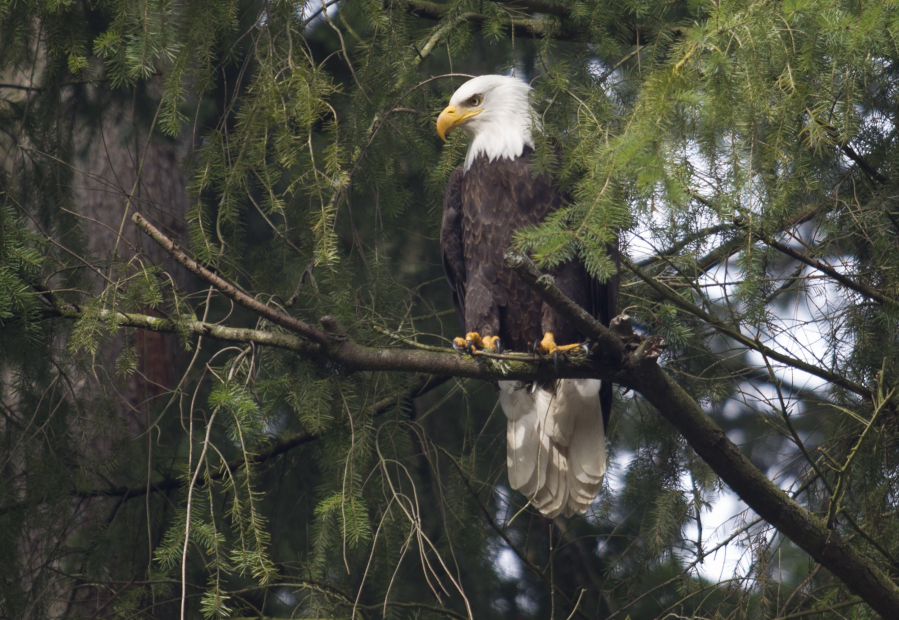While the strength of America’s democracy may be up for debate after a long election year, one of its most recognizable symbols looks as strong as it’s been in at least half a century.
Bald eagle sightings still generate plenty of excitement from birdwatchers and non-birdwatchers alike, according to Yakima Valley Audubon Society Board of Directors president Kerry Turley. They’ve grown much easier to spot over the last four decades, culminating in the Washington Department of Fish and Wildlife’s decision to officially take bald eagles and peregrine falcons off the state’s endangered list earlier this month.
A nationwide conservation success story held especially true in Washington, where the wildlife department counted 1,334 known territories in 2015. Natural resource scientist Joseph Buchanan noted it’s hard to guess the exact number of eagles with no intensive surveys in recent years, since they don’t need much forest to build their nests.
“The bald eagle population in Washington is very large,” said Buchanan, who co-authored with Kevin Kalasz the wildlife department’s report recommending for delisting. “All the information that we have indicates that the population is robust and is continuing to increase.”
Long road back
Bald eagles once thrived throughout the continental United States, and a 2007 wildlife department report estimated around 8,800 eagles lived in Washington when white settlers first arrived in the late 1700s.
Although they remained prevalent in Alaska, hunting, loss of habitats and water contaminants from chemicals such as DDT took a huge toll on the birds in the lower 48 states. The U.S. Fish and Wildlife Department said bald eagles hit a low of 400 nesting pairs in 1963, when officials said Washington was one of a few states to still support breeding.
This year’s status report said only 104 nesting pairs lived in Washington as of 1980. Still, the following year, the state was home to an estimated 10 percent of the entire population in the lower 48.
A national ban on the agricultural use of DDT in 1972 marked a key turning point for bald eagles in Washington and throughout the country. Increased conservation efforts and habitat management also played a key role in returning the massive birds of prey to their former glory.
By 1995, an estimated 4,450 breeding pairs nationwide led the U.S. Department of Fish and Wildlife to downgrade bald eagles from endangered to threatened. In 2007, they left the federal list entirely and a year later Washington downgraded them from threatened to sensitive with close to 1,000 nesting pairs and 3,500 to 4,000 eagles in the winter, according to a wildlife department report.
That report noted nearly 3,000 Washington landowners signed management plans from 1986 to 2007, under a state statute no longer valid since eagles were downlisted to sensitive. This year’s status review indicates existing protection measures should still ensure an anticipated increase in human population won’t negatively affect bald eagles, especially since they are adapting to human activity.
The wildlife department’s listing and recovery section manager, Hannah Anderson, said a steady growth of bald eagles in Washington began in the late ’70s. Their presence also indicates a healthy ecosystem, although the status review notes high levels of lead in prey still causes some problems.
“They’re sort of top-tier and they’re also carrion eaters,” Anderson said. “They provide a good service there.”
At some point she expects to see the bald eagle population level off, although it has already exceeded carrying capacity in certain areas. Observers have seen failed attempts to establish new territories in close proximity to other eagles, according to Buchanan.
The recent delisting won’t remove critical federal protections for bald eagles, which were one of the first put on the precursor to the federal Endangered Species List in 1967. The Bald and Golden Eagle Protection Act became the first to defend the birds from hunters in 1940, and in 1972, they were added to the list of species in the Migratory Bird Treaty Act.
The Lacey Act of 1900 further diminishes the black market with a ban on trafficking in illegal wildlife. Violators can face fines of up to $500,000 or five years in prison if convicted.
Eagles in the Valley
Although the vast majority of Washington’s bald eagles live west of the Cascades, the majestic birds can often be found at certain spots in the Yakima Valley, especially during winter.
Turley, the Audubon Society president, compiles the weekly bird alert noting all species spotted in the area. He said as little as 15 years ago, bald eagles were considered exclusively a “winter visitor” in Yakima County.
Today, they can be found breeding around Granger and in their most popular spot, the Yakima River Valley. Healthier water makes it a prime spot for bald eagles since fish are typically their primary source of food.
Buchanan said the wildlife department’s bald eagle management guidelines help prevent new development from disturbing nests. Other forest practices rules protect nest trees as well.



